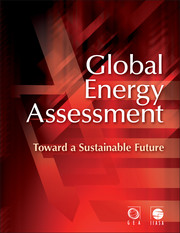Book contents
- Frontmatter
- Contents
- Section 1
- Section 2
- Section 3
- Cluster 1
- Cluster 2
- Chapter 7 Energy Resources and Potentials
- Chapter 8 Energy End-Use: Industry
- Chapter 9 Energy End-Use: Transport
- Chapter 10 Energy End-Use: Buildings
- Chapter 11 Renewable Energy
- Chapter 12 Fossil Energy
- Chapter 13 Carbon Capture and Storage
- Chapter 14 Nuclear Energy
- Chapter 15 Energy Supply Systems
- Chapter 16 Transitions in Energy Systems
- Cluster 3
- Cluster 4
- Section 4
- Index
- References
Chapter 13 - Carbon Capture and Storage
Published online by Cambridge University Press: 05 September 2012
- Frontmatter
- Contents
- Section 1
- Section 2
- Section 3
- Cluster 1
- Cluster 2
- Chapter 7 Energy Resources and Potentials
- Chapter 8 Energy End-Use: Industry
- Chapter 9 Energy End-Use: Transport
- Chapter 10 Energy End-Use: Buildings
- Chapter 11 Renewable Energy
- Chapter 12 Fossil Energy
- Chapter 13 Carbon Capture and Storage
- Chapter 14 Nuclear Energy
- Chapter 15 Energy Supply Systems
- Chapter 16 Transitions in Energy Systems
- Cluster 3
- Cluster 4
- Section 4
- Index
- References
Summary
Executive Summary
Emissions of carbon dioxide, the most important long-lived anthropogenic greenhouse gas, can be reduced by Carbon Capture and Storage (CCS). CCS involves the integration of four elements: CO2 capture, compression of the CO2 from a gas to a liquid or a denser gas, transportation of pressurized CO2 from the point of capture to the storage location, and isolation from the atmosphere by storage in deep underground rock formations. Considering full life-cycle emissions, CCS technology can reduce 65–85% of CO2 emissions from fossil fuel combustion from stationary sources, although greater reductions may be possible if low emission technologies are applied to activities beyond the plant boundary, such as fuel transportation.
CCS is applicable to many stationary CO2 sources, including the power generation, refining, building materials, and the industrial sector. The recent emphasis on the use of CCS primarily to reduce emissions from coal-fired electricity production is too narrow a vision for CCS.
Interest in CCS is growing rapidly around the world. Over the past decade there has been a remarkable increase in interest and investment in CCS. Whereas a decade ago, there was only one operating CCS project and little industry or government investment in R&D, and no financial incentives to promote CCS. In 2010, numerous projects of various sizes are active, including at least five large-scale full CCS projects. In 2015, it is expected that 15 large-scale, full-chain CCS projects will be running. Governments and industry have committed over USD 26 billion for R&D, scale-up and deployment.
- Type
- Chapter
- Information
- Global Energy AssessmentToward a Sustainable Future, pp. 993 - 1068Publisher: Cambridge University PressPrint publication year: 2012
References
- 35
- Cited by

